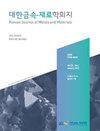NiZnS复合光催化剂中硫含量对太阳水分解的影响
IF 1.4
4区 材料科学
Q4 MATERIALS SCIENCE, MULTIDISCIPLINARY
引用次数: 0
摘要
太阳能作为一种满足未来能源需求的环保能源正备受关注。本文采用水热法在不同硫含量下合成了NiZnS光催化剂。ZnS材料由于其高稳定性、低毒性和优异的电荷分离特性而被广泛用作光催化剂。镍被认为是ZnS基体中的共组分,以提高析氢效率,因为硫化镍具有窄的带隙。场发射扫描电子显微镜分析用于观察颗粒的大小和形状。随着硫比的增加,颗粒尺寸增加,并且在2∶2摩尔比的NiZn:S下获得相对均匀的颗粒尺寸。X射线衍射仪分析表明,在低含硫量的NiZnS光催化剂中形成了ZnO晶体。在各种NiZnS成分中,NiZn:S的比例为2:2,产生的氢气速率最高(1541.5μmol/g/h),具有稳定的再现性。用紫外-可见光谱法分析了ZnO的吸光率,用X射线光电子能谱仪鉴定了ZnO中氧空位引起的带隙随硫含量的不同而变化。用于引入硫的大量硫脲增加了颗粒尺寸,阻挡了阳光照射到NiZnS表面,从而降低了光催化性能。因此,在制备NiZnS复合光催化剂时,改变硫含量会影响材料的晶体结构和能带特性,最终提高光催化剂的光吸收、电荷分离和制氢率。本文章由计算机程序翻译,如有差异,请以英文原文为准。
Effect of Sulfur Contents in NiZnS Composite Photocatalysts on Solar Water Splitting
Solar energy is attracting much attention as an eco-friendly source for future energy needs. Herein, NiZnS photocatalysts were synthesized with a hydrothermal method at various sulfur contents. The ZnS material is widely used as a photocatalyst because of its high stability, low toxicity, and excellent charge separation characteristics. Nickel is considered a co-component in the ZnS base to improve hydrogen evolution efficiency, because nickel sulfide has a narrow band gap. Field emission scanning electron microscopy analysis was used to observe particle size and shape. As the sulfur ratio increased, the particle size increased, and relatively uniform particle sizes were obtained at the 2:2 molar ratio of NiZn:S. X-ray diffractometer analysis showed the formation of ZnO crystals at low sulfur contents in the NiZnS photocatalysts. Among the various NiZnS compositions, the NiZn:S ratio of 2:2 resulted in the highest hydrogen production rate (1541.5 μmol/g/h) with stable reproducibility. UV-vis spectroscopy was used to analyze light absorbance, and the band gap changed with different sulfur contents due to the oxygen vacancies in ZnO, as identified by X-ray photoelectron spectroscope. High amounts of thiourea used to introduce the sulfur increased the particle sizes and blocked sunlight coming to NiZnS surfaces, thereby degrading photocatalytic performance. Therefore, changing the sulfur content when fabricating the NiZnS composite photocatalysts affected the crystalline structures and band characteristics of the materials, and it finally resulted in improved light absorption, charge separation, and the hydrogen production rate of the photocatalysts.
求助全文
通过发布文献求助,成功后即可免费获取论文全文。
去求助
来源期刊

Korean Journal of Metals and Materials
MATERIALS SCIENCE, MULTIDISCIPLINARY-METALLURGY & METALLURGICAL ENGINEERING
CiteScore
1.80
自引率
58.30%
发文量
100
审稿时长
4-8 weeks
期刊介绍:
The Korean Journal of Metals and Materials is a representative Korean-language journal of the Korean Institute of Metals and Materials (KIM); it publishes domestic and foreign academic papers related to metals and materials, in abroad range of fields from metals and materials to nano-materials, biomaterials, functional materials, energy materials, and new materials, and its official ISO designation is Korean J. Met. Mater.
 求助内容:
求助内容: 应助结果提醒方式:
应助结果提醒方式:


